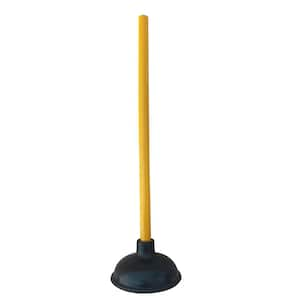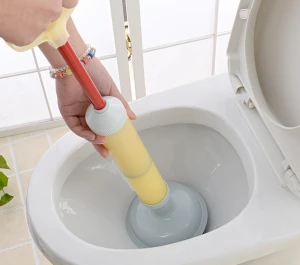Tips to Properly Apply Plunger and Drain Cleaner: Pro Guidance
Tips to Properly Apply Plunger and Drain Cleaner: Pro Guidance
Blog Article
Almost everyone may have their unique piece of advice with regards to Here's How to Correctly Use a Toilet Plunger.

Intro
Proper maintenance of household drains pipes is crucial for preventing clogs and guaranteeing smooth water flow. Among the trick devices in every home owner's toolkit is the plunger, together with numerous drainpipe cleaners developed to deal with persistent obstructions effectively. This short article checks out exactly how to utilize plungers and drain cleaners efficiently to keep your drains flowing freely.
Section 1: Understanding Bettors
Sorts of Plungers
There are numerous kinds of plungers available, each designed for various kinds of drains and clogs. One of the most typical types consist of mug plungers, flange bettors, and accordion bettors.
How Plungers Work
Plungers work on the concept of developing stress and suction to remove blockages. When appropriately used over a drainpipe, they develop a vacuum that can pull out debris or break up blockages.
Choosing the Right Plunger
Selecting the right plunger depends on the sort of drainpipe and the nature of the clog. Mug bettors are excellent for sinks and bathtubs, while flange bettors are much better fit for bathrooms due to their layout.
Usual Mistakes with Bettors
Avoiding these errors makes certain effective plunging: incorrect seal around the drainpipe, insufficient pressure, and not clearing bordering particles.
Section 2: Utilizing Plungers Effectively
Preparation
Prior to diving, make certain the bettor covers the drainpipe completely and develops a tight seal. Clear any visible debris around the drain opening.
Technique
Start with mild plunging movements to develop suction. Increase stress slowly, using a steady rhythm. Repeat as essential up until the drain removes.
Troubleshooting Tips
If diving doesn't function, try readjusting the seal, applying oil jelly for a better seal, or utilizing a various kind of plunger.
Section 3: Recognizing Drain Cleansers
Sorts Of Drain Cleansers
Drain pipes cleaners can be chemical or enzymatic. Chemical cleansers make use of solid chemicals to dissolve blockages, while chemical cleansers make use of all-natural enzymes to break down organic matter.
Exactly How Drainpipe Cleaning Company Job
Chemical cleansers respond with obstructions to dissolve them, while chemical cleansers break down organic products like hair and grease without harming pipes.
Safety Considerations
Always use handwear covers and eye defense when making use of chemical drain cleansers. Make sure ample air flow and follow manufacturer instructions carefully.
Eco-Friendly Alternatives
Consider making use of vinegar and cooking soda or enzyme-based cleansers for green choices that are safer for pipelines and the environment.
Area 4: Using Drainpipe Cleaners Successfully
Application Techniques
Put chemical cleansers directly right into the drain opening. Enable them to benefit the suggested time prior to purging with hot water. Enzymatic cleansers should sit over night.
Preventative measures
Avoid mixing various sorts of cleansers, as this can produce harmful fumes. Never utilize chemical cleansers in conjunction with a plunger, as splashing can occur.
Dealing With Persistent Blockages
For relentless clogs, take into consideration utilizing a pipes snake or calling an expert plumbing to avoid damages to pipes.
Final thought
In conclusion, comprehending just how to use bettors and drainpipe cleansers efficiently is crucial for maintaining healthy and balanced pipes systems. By picking the right devices and methods, house owners can deal with minor blockages and avoid significant plumbing concerns down the line.
4 DIY Ways to Unclog Drains
Wire Hanger
This age-old technique has been used by many an amateur plumber – to much success. Take any wire hanger, deconstruct its shape and leave a small hook shape on the end. Time to go fishing! Remove the shower or sink drain cover and snake the wire into the drain, wiggling and rotating it as you push it through. Dispose of the gunk that you remove and flush the drain with hot water. Rinse with a pan of boiling water for best results.
Plunger
Creating a suction in your drain can break up clogs caused by hair and soap residue build up. First, make sure you are using the correct type of plunger, one specifically for sinks or tubs. They are typically smaller than regular toilet plungers and often have a shallow suction cup. Regular plungers can work too but we’d recommend cleaning them first and finding a way to create better suction over the drain.
Baking Soda and Vinegar
This technique is a classic – and one of the most popular DIY drain unclog methods. Pour one cup of baking soda and one cup of vinegar down the drain and allow it to work its magic overnight. The next morning, flush the drain with boiling water. Repeat if necessary.
Drain Snake/Hair Clog Tool
If you know your clog is caused primary by hair, a drain snake/hair clog tool might be your best option. These tools can be purchased for under $10 at any hardware store and work well so long as the clog isn’t too deep in the drain.
https://www.callcatons.com/blog/four-diy-ways-to-unclog-drains/

Application Techniques
Put chemical cleansers directly right into the drain opening. Enable them to benefit the suggested time prior to purging with hot water. Enzymatic cleansers should sit over night.
Preventative measures
Avoid mixing various sorts of cleansers, as this can produce harmful fumes. Never utilize chemical cleansers in conjunction with a plunger, as splashing can occur.
Dealing With Persistent Blockages
For relentless clogs, take into consideration utilizing a pipes snake or calling an expert plumbing to avoid damages to pipes.
Final thought
In conclusion, comprehending just how to use bettors and drainpipe cleansers efficiently is crucial for maintaining healthy and balanced pipes systems. By picking the right devices and methods, house owners can deal with minor blockages and avoid significant plumbing concerns down the line.
4 DIY Ways to Unclog Drains
Wire Hanger
This age-old technique has been used by many an amateur plumber – to much success. Take any wire hanger, deconstruct its shape and leave a small hook shape on the end. Time to go fishing! Remove the shower or sink drain cover and snake the wire into the drain, wiggling and rotating it as you push it through. Dispose of the gunk that you remove and flush the drain with hot water. Rinse with a pan of boiling water for best results.
Plunger
Creating a suction in your drain can break up clogs caused by hair and soap residue build up. First, make sure you are using the correct type of plunger, one specifically for sinks or tubs. They are typically smaller than regular toilet plungers and often have a shallow suction cup. Regular plungers can work too but we’d recommend cleaning them first and finding a way to create better suction over the drain.
Baking Soda and Vinegar
This technique is a classic – and one of the most popular DIY drain unclog methods. Pour one cup of baking soda and one cup of vinegar down the drain and allow it to work its magic overnight. The next morning, flush the drain with boiling water. Repeat if necessary.
Drain Snake/Hair Clog Tool
If you know your clog is caused primary by hair, a drain snake/hair clog tool might be your best option. These tools can be purchased for under $10 at any hardware store and work well so long as the clog isn’t too deep in the drain.
https://www.callcatons.com/blog/four-diy-ways-to-unclog-drains/

As a person who reads about , I was thinking sharing that piece of content was worthwhile. Enjoyed our piece? Please quickly share it. Help others locate it. Thank-you for going through it.
Click Here Report this page